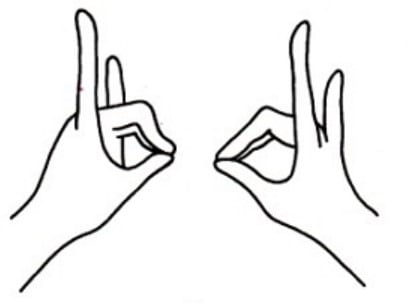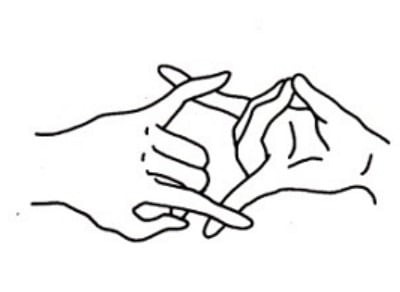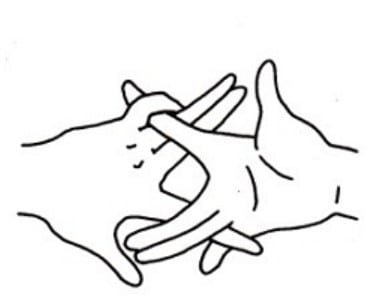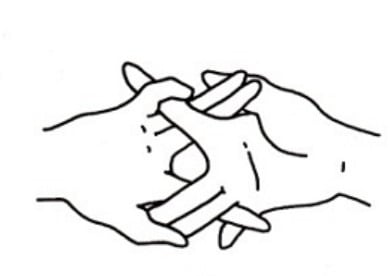Previously: The Samara Sleepover Game.
Note: Please don’t copy/paste, republish, or narrate this post on other websites, video platforms, etc. without permission.
Today, something short and sweet: The Fox Window Game, a method for how to see ghosts by simply making your hands into a specific shape and peering through them. In Japan, where it originates, the name of the game is written 狐の窓; (Kitsune no mado, literally Fox Window); meanwhile, in Korea, where it’s been making the rounds since at least 2012, it’s called 여우창문 (yeouchangmun, again, Fox Window). There’s been a resurgence in popularity of the Fox Window Game in Korea recently, as well; it kicked up a ton of interest on social media over there in 2020. As far as I know, it’s never appeared on the internet in English before now. (If it has, I haven’t seen it; the below is all the results of my own research digging through Japanese and Korean sources.)

But here’s the thing about the Fox Window Game: It’s not a piece of internet folklore. It’s old. I don’t know precisely how old, but I do know that’s been in practice for at least a century or two.
Several notable folklorists and anthropologists, including Kunio Yanagita and Kumagusu Minakata, documented it in the early parts of the 20th century; however, there’s also evidence that it was in use during the Edo period, as well. (For those unfamiliar, the Edo period ran roughly from 1603 to 1867.)
More recently, Toru Tsunemitsu included it in his 2006 work Shigusa no Minzokugaku: Jujutsuteki Sekai to Shinsei, or Folklore Of Gestures: Magical World And Spirit; additionally, it factors prominently in the (sadly now out of print) collection of fairy tales by Naoka Awa titled The Fox’s Window And Other Stories, translated into English and published posthumously circa 2010. It even pops up in one of the Gakko no Kaidan films, which are based on Tsunemitsu’s popular Gakko no Kaidan(School Ghost Stories) book series: 2014’s Gakko no Kaidan: Noroi no Kotodama.
[Like what you read? Check out Dangerous Games To Play In The Dark, available from Chronicle Books now!]
Foxes, of course, are major players in Japanese folklore, religion, and mythology: There are shrines dedicated to the kami with which they’re associated, Inari, across Japan; numerous yokai are fox-like in appearance, personality, or both; and they often fulfill the role of the trickster in stories and tales. Additionally, the more tails a fox has, the wiser it’s supposed to be.
The practice of forming a Fox Window is often referred to as children’s play, kind of the way Pat-a-Cake and other clapping and hand games in English-speaking cultures are. But then again, games like Bloody Mary are also considered children’s play in many circles — so, just because it’s ostensibly a kid’s game doesn’t mean it shouldn’t be approached with caution.
It’s also… not easy to twist your hands into the correct shape for this one. I had trouble with it, so be prepared to exercise some flexibility. Also, please don’t bend your fingers in ways they don’t want to bend. Listen to your body when it tells you what it can and can’t do. I do not want you breaking or dislocating your own fingers in an attempt to play this game, and I am not responsible if you do.
And, as always: Play at your own risk.
Players:
- One principal.
Requirements:
- Two hands, with five fingers apiece.
Instructions:
- Begin at any time.
- Hold your hands up in front of your face.
- On each hand, bend your middle and ring fingers in towards your palm. Then, bring your thumbs up to meet them. Your hands should both resemble the head of a fox, like so:

- Keeping your fingers in that position, rotate your right hand outwards — that is, your index finger should be moving away from your body — so that the palm of your right hand is now facing upwards. You may need to make use of your elbow and shoulder to place your hand in this position.
- Now, again keeping your fingers in that position, rotate your left hand towards you slightly — that is, your index finger should be moving towards your body — so that the back of your hand is facing upwards. Again, you may need to make use of your elbow and shoulder to place your hand in this position.
- Continuing to keep your fingers in their current positions — middle and ring fingers pinched together with your thumbs — gently slot your hands together, so that the index finger of your right hand is underneath the pinky finger of your left hand, and the pinky finger of your right hand is underneath the index finger of your left hand. Your hands should now be in the following position:

- Keeping your hands in their current positions, release your middle and ring fingers from your thumbs and extend them outward. Your hands should now be open flat and laced together such that your right index finger is sandwiched between your left pinky and ring and middle fingers and your left index is slotted between your right pinky and ring and middle fingers.
- Now, curl your left pinky around your right index finger and tuck it behind your left ring and middle fingers. Be careful. If you are unable to perform this action without discomfort, DO NOT PROCEED.
- If you are successful, a small window should be forming between the index and middle fingers of both your hands. The arrangement should now look like this:

- Now, gently tuck your right thumb behind your left ring and middle fingers. Then, tuck your left thumb in front of your right ring and middle fingers. Again, be careful. If you are unable to perform this action without discomfort, DO NOT PROCEED.
- If you are successful, the window should now be complete. The finished arrangement should look as follows:

- Now: Maintaining this arrangement, hold your hands up in front of your face.
- Look through the window formed by your fingers.
- Look carefully.
- What do you see?
- If you see nothing out of the ordinary: There are no spirits present. To close the window, release. You may try another time or in another location, if you wish.
- If you see… something that shouldn’t be there: Take note of it; then release your hands from the arrangement immediately. Do not dawdle; speed is of the essence.
- Once you have released your hands and closed the window, you may carry on with your life.
- But know this: Closing the window doesn’t send whatever it may have revealed to you away.
- It simply makes it so you can’t see it anymore.
- It’s still there.
- Waiting.
Additional Notes:
Do not force your hands into the arrangement necessary to perform this ritual if they do not want to be arranged as such. If, at any point, you experience discomfort or pain, release your hands and terminate the ritual. Do not hurt yourself attempting to play.
Do not look at other living people through the window.
Do not look through a window made by another person.
If you see something through the window when you look, you MUST close the window immediately.
Should you fail to follow these stipulations, you may find yourself on the receiving end of a curse.
Do not fail to follow these stipulations.
A Final Warning:
Before you look, make sure you really want to see what you think you want to see.
Sometimes, ignorance is bliss.
***
Please don’t copy, republish, or narrate this post on other sites without permission (TikTokkers, that includes you). Linking to it or sharing the URL is fine (and encouraged!), as is writing your own unique version of the game based on your own research, but copying and pasting, republishing, or otherwise reproducing the text of this piece in its entirety or near-entirety on other websites without permission, or summarizing it without credit and passing off the work and research as your own, isn’t.
***
Follow The Ghost In My Machine on Twitter @GhostMachine13 and on Facebook @TheGhostInMyMachine. And for more games, don’t forget to check out Dangerous Games To Play In The Dark, available now from Chronicle Books!
[Photo via Erik_Karits/Pixabay, remixed by Lucia Peters; the diagrams, meanwhile, have been circulating social media for some time.]